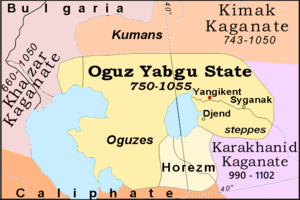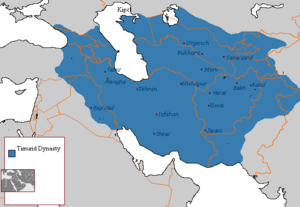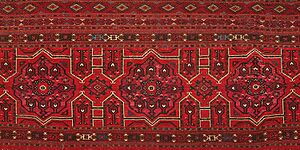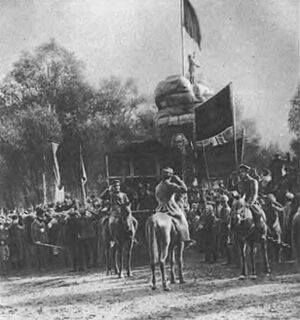History of Turkmenistan facts for kids
The history of Turkmenistan began a very long time ago, around 2000 BC, when Indo-European tribes arrived. These early groups were often nomads or semi-nomads because the land was very dry, making it hard to grow crops. Central Asia was part of a huge area where horse-riding cultures thrived, including groups like the Massagatae, Scythians, and early Soghdians. Turkmenistan was a busy pathway for many tribes moving towards richer lands in the south, like ancient Mesopotamia and the Indus Valley civilization.
Written history started when the Achaemenid Empire from Ancient Iran conquered the region. Later, many other groups took control, including Alexander the Great, the Parthians, and the Sassanid Iranians. In these early times, most people in Turkmenistan followed Zoroastrianism or Buddhism, and Iranian cultures were very strong. However, two later groups changed the region forever: the Arabs and the Oghuz Turks. The Arabs brought Islam, and most people became Muslims. The Oghuz brought the Turkic Turkmen language, which is now spoken there. This Turkic period was a time of great cultural mixing and growth. The city of Merv became a major center for trade, science, and new ideas, and it was even a capital for some Islamic empires. Later, Turkic rulers like the Seljuks also shaped the culture. The Mongol invasions led by Genghis Khan in the Middle Ages caused a lot of destruction, but their rule didn't last long. Later, Timur and the Uzbeks also fought for control of the land.
Modern Turkmenistan changed a lot when the Russian Empire took over in the late 1800s. After the Russian Revolution of 1917, Turkmenistan became an industrialized socialist republic as part of the Soviet Union. Turkmenistan became independent in 1991. Saparmurat Niyazov, a former leader from the Soviet era, became the first president. He called himself Turkmenbashi, meaning 'Leader of the Turkmen', and ruled the country as a very strict dictatorship until he died in 2006. Turkmenistan has not become a democracy like many other former Soviet countries. After Niyazov, Gurbanguly Berdimuhamedow became president in an election with no real competition. He changed some of Niyazov's unusual rules and started some economic improvements. In March 2022, Gurbanguly Berdimuhamedow was followed by his son, Serdar Berdimuhamedow, which created a kind of family rule.
Contents
Ancient History of Turkmenistan
Not many old remains have been found, but some suggest that early humans, possibly even Neanderthals, lived east of the Caspian Sea. However, this area has not been fully explored by archaeologists.
Discoveries from the Bronze Age and Iron Age show that advanced civilizations existed here. These include finds linked to the Bactria-Margiana Archaeological Complex (BMAC) near modern Mary (which was once Merv), Djeitun, and Gonur Tepe.
Around 2000 BCE, Indo-European peoples settled across the region. Most of what is now Turkmenistan was home to BMAC societies and the Dahae, a group of tribes living just east of the Caspian Sea. The Massagetae and Scythians also lived north of these groups.
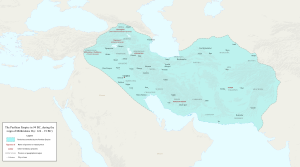
Alexander the Great conquered this land in the 4th century BC while on his way to South Asia. In 330 BC, Alexander moved north into Central Asia. He founded a city called Alexandria near the Murghab River. This city was on an important trade route and later became the famous city of Merv. The ancient ruins of Alexander's city are still there and have been studied a lot. After Alexander died, his empire quickly broke apart. The region was ruled by the Seleucids before the local governor of Parthia declared independence. The Parthians, who were strong, nomadic warriors from northern Iran, then created the kingdom of Parthia. This kingdom included modern-day Turkmenistan and Iran. The Parthian kings ruled from the city of Nisa, which is now close to the capital city of Ashgabat. Nisa was founded by Arsaces I (who ruled around 250–211 BC). It was thought to be where Parthian kings were buried, but this isn't fully proven.
Excavations at Nisa have uncovered large buildings, burial sites, and shrines. Many written documents and a looted treasure have also been found. Many beautiful Greek-style artworks were discovered, along with many ivory drinking horns (rhytons). These horns were decorated with Iranian designs or scenes from Greek myths.
From the 4th to the early 7th century CE, many people lived in settlements along the fertile river valleys of the Amu Darya. Merv and Nisa became important centers for sericulture (raising silkworms). A busy trade route, connecting Tang dynasty China and the city of Baghdad (in modern Iraq), passed through Merv. This made Merv a very valuable city for any conqueror.
Arab Conquests and the Spread of Islam
Central Asia came under Arab control after a series of invasions in the late 600s and early 700s. It became part of the Islamic Caliphate, divided into provinces. The Arab conquest brought the religion of Islam to all the people of Central Asia. The city of Merv was taken by the caliph Uthman ibn Affan's commanders and became the capital of the Khorasan province. From Merv, the Arabs, led by Qutayba ibn Muslim, conquered Balkh, Bokhara, Fergana, and Kashgaria. They even reached China in the early 700s.
Merv gained political importance in February 748 when Abu Muslim (died 750) declared a new Abbasid dynasty there. He then set out from Merv to conquer Iran and Iraq and establish a new capital in Baghdad.
Later, in the 700s, Merv became known for some different religious ideas preached by al-Muqanna, "The Veiled Prophet of Khorasan." Present-day Turkmenistan was ruled by the Tahirid dynasty between 821 and 873. In 873, Arab rule in Central Asia ended after the Saffarid conquest. During their time, Merv, like Samarkand and Bokhara, was a great center of learning. The famous historian Yaqut studied in its libraries. Merv produced many scholars in areas like Islamic law, Hadith (sayings of the Prophet), and history. Many scholars were known by the name Marwazi, meaning they were from Merv. But Saffarid rule was short, and they were defeated by the Samanids in 901. The Samanid dynasty became weaker after the mid-900s, and the Ghaznavids took over present-day Turkmenistan in the 990s. However, they faced challenges from the Seljuks, who were new arrivals from the north. After the Seljuks won a major victory against them, present-day Turkmenistan came under Seljuk rule in 1041.
The Oghuz Tribes
The ancestors of the Turkmen can be traced back to the Oghuz confederation. These were groups of nomadic tribes in the early Middle Ages, living in what is now Mongolia and around Lake Baikal in southern Siberia. These Turkic-speaking peoples formed the basis of powerful empires in Inner Asia. In the late 700s, Oghuz groups moved through Jungaria into Central Asia. Arabic writings from the 700s mention them as "Guzz" in the area of the middle and lower Syrdariya River. By the 900s, the Oghuz had spread west and north of the Aral Sea and into the plains of modern-day Kazakhstan. They absorbed both Iranian and other Turkic groups. In the 1000s, the famous Muslim Turkic scholar Mahmud al-Kashgari described the Oghuz and Turkmen languages as different from other Turkic languages. He listed twenty-two Oghuz clans, some of which appear in later Turkmen stories as the core of the early Turkmen people.
The Oghuz expanded their territory through military campaigns, reaching at least as far as the Volga River and Ural Mountains. However, the exact borders of their power in the steppe areas north and west of the Aral Sea changed over time. Accounts from Arab geographers and travelers describe the Oghuz as not having one central leader. Instead, they were ruled by many "kings" and "chieftains." Because they were so spread out and lacked a single strong government, Oghuz tribes rarely worked together. By the late 900s, their confederation began to weaken. Around that time, a clan leader named Seljuk founded a dynasty and an empire named after him. This empire was built on the Oghuz groups that had moved south into present-day Turkmenistan and Iran. The Seljuk Empire was centered in Persia, and from there, Oghuz groups spread into Azerbaijan and Anatolia.
After the fall of the Göktürk kingdom, Oghuz tribes moved to the area of Transoxiana, in western Turkestan, which is now in Kazakhstan and Kyrgyzstan. This land became known as the "Oghuz steppe," an area between the Caspian and Aral seas. An Arab historian, Ibn al-Athir, wrote that the Oghuz Turks came to Transoxiana between 775 and 785. By 780 AD, the eastern parts of the Syr Darya were ruled by the Karluk Turks, and the western region (Oghuz steppe) was ruled by the Oghuz Turks.
The name "Turkmen" first appeared in writings in the 900s. It was used to tell apart those Oghuz groups who moved south into the Seljuk lands and became Muslims from those who stayed in the steppe. Slowly, the term became an ethnic name and was used only for Muslim Oghuz, especially those who moved away from the Syrdariya Basin. By the 1200s, the name Turkmen completely replaced "Oghuz." The origin of the word Turkmen is still not fully clear. Some popular ideas from the 1000s say it comes from "Turk" plus the Iranian word "manand," meaning "resembling a Turk." Modern scholars, however, suggest that "man" or "men" makes the word stronger, so it could mean "pure Turk" or "most Turk-like of the Turks."
The Seljuks

In the 1000s, the Seljuk lands stretched from the Amu Darya river delta into Iran, Iraq, the Caucasus region, Syria, and Asia Minor. In 1040, the Seljuk Turks crossed the Oxus River from the north. They defeated Masud, the sultan of Ghazni, and made Toghrul Beg, the grandson of Seljuk, the new ruler of Iran. This marked the start of the Seljukid dynasty, with its capital at Nishapur. Toghrul's younger brother, Daud, took control of Merv and Herat. Toghrul was followed by his nephew Alp Arslan (the Great Lion), who was buried at Merv. Around this time, Merv reached its peak of glory. In 1055, Seljuk forces entered Baghdad, becoming masters of the Islamic heartlands and important supporters of Islamic learning and institutions. Until later revolts, Turkmen tribesmen were a key part of the Seljuk army. Turkmen families and their belongings moved with Seljuk campaigns into Azerbaijan and Anatolia. This process began the "Turkification" of these areas, meaning more Turkic people and culture spread there. During this time, Turkmen also began to settle in the area of present-day Turkmenistan. Before the Turkmen arrived, most of this desert land was empty. The more livable areas along the Caspian Sea, Kopetdag Mountains, Amu Darya, and Murgap River were mostly populated by Iranians. The city-state of Merv was a particularly large farming area, important as both a regional economic and cultural center and a stop on the Silk Road. The last powerful Seljuk ruler, Sultan Sanjar (died 1157), saw his empire break apart and be destroyed by attacks from Turkmen and other tribes. During Sultan Sanjar's rule, in the mid-1100s, Merv was taken over by the Ghuzz Turkic tribes from beyond the Oxus. It eventually came under the control of the rulers of Khwarizm (Khiva). After mixing with the settled peoples in Turkmenistan, the Oghuz living north of the Kopet-Dag Mountains gradually became known as the Turkmen.
The Seljuk empire fell apart in the second half of the 1100s, and the Turkmen became independent tribal groups.
Mongols and Timurids
In 1157, the Seljuk dynasty's rule ended in the province of Khorasan. The Turkic rulers of Khiva, known as Khwarezmshahs, took control of Turkmenistan. But in 1221, Central Asia suffered a terrible invasion by Mongol warriors who swept across the region from eastern Asia.
Led by their commander, Genghis Khan, who founded the Mongol Empire, the Mongols conquered Khwarezm and burned the city of Merv to the ground. The Mongol leader ordered the killing of Merv's people and the destruction of the farms and irrigation systems. This effectively ended the strong Iranian influence in the cities and farming communities of Khwarezm. These areas were soon repopulated by the Turkmen who survived the invasion. Many had moved north to the plains of Kazakhstan or west to the Caspian Sea. After the division of the Mongol Empire, present-day Turkmenistan mostly went to the Chagatai Khanate, except for the southernmost part, which belonged to the Ilkhanate.
Later, in the 1300s, small, semi-independent states appeared under the rule of local tribal chiefs. In the 1370s, Amir Timur (also known as Tamerlane), one of history's greatest conquerors, captured the Turkmen states once more. He established the short-lived Timurid Empire, which collapsed after Timur's death in 1405. After that, the Turkmens became independent again.
New Tribal Groups
Overall, the 1300s to 1500s was a time when the Turkmen, after being displaced by the Mongol invasions, formed new political groups. These groups became the tribal groupings that still exist today.
Historical records also show that a large tribal union called the Salor confederation remained from the original Oghuz tribes and continued into modern times. In the late 1600s, this confederation broke apart. Three main tribes moved eastward and then southward. Of these, the Yomud split into eastern and western groups. The Teke moved to the Ahal region near the Kopetdag Mountains and eventually into the Murghab River basin. Other Salor tribes moved to the area near the Amu Darya delta and other parts of modern-day southeastern Turkmenistan. Salor groups also live in Turkey, Afghanistan, Uzbekistan, and China.
Turkmenistan in the 1500s and 1600s
The history of Turkmenistan from the 1500s to the 1800s is mostly about its relationships with the states of Iran, Khiva, Bukhara, and Afghanistan. Wars during this period mostly happened in the lands of Turkmenistan. The invasion by the Khan of Khiva, Abul Gazi Bahadur Khan, from 1645 to 1663, caused problems for the Turkmens. This, along with a drought around the same time, made most Turkmens within the khanate move to areas around Ahal, Atrek, Murgap, and Tejen. During this period, many Turkmen tribes living around the Aral Sea also moved because of pressure from both the Khiva Khanate and the Kalmyks. They migrated to Astrakhan and Stavropol in the northern Caucasus.
Popular epic poems like Koroglu, and other oral stories, developed during this time. This period can be seen as the beginning of the Turkmen nation. Poets and thinkers like Devlet Mehmed Azadi and Magtymguly Pyragy became voices for this new nation, calling for unity, brotherhood, and peace among Turkmen tribes. Magtymguly Pyragy is honored in Turkmenistan as the father of national literature. Most of present-day Turkmenistan was divided between the Khanates of Khiva and Bukhara, except for the southernmost parts, which belonged to Persia. Nader, the Shah of Persia, conquered it in 1740. But after he was killed in 1747, the Turkmen lands were taken back by the Uzbek khanates of Khiva and Bukhara. In the 1830s, the Teke Turkmen, who then lived on the Tejen River, were forced by the Persians to move northward. Khiva fought against the Tekes' advance, but eventually, around 1856, the Teke became the main power in the southern and southeastern parts of present-day Turkmenistan.
Russian Takeover and the Great Game
In the 1700s, Turkoman tribes came into contact with the Russian Empire. The Russian Empire began to move into the area in 1869 by setting up the Caspian Sea port of Krasnovodsk, which is now Turkmenbashy. After the Emirate of Bukhara (1868) and the Khanate of Khiva (1873) were brought under Russian influence, the Turkmen area remained independent for a while. The Russians decided to move into the Transcaspian region, saying they wanted to stop the Turkmen slave trade and banditry. Turkmen tribal groups were involved in the Khivan slave trade and the Bukhara slave trade. They regularly carried out slave raids, called alaman, against Russian and German settlers along the Ural River, and Persian pilgrims to Mashad. These groups were seen as acceptable targets for enslavement by the Sunni Muslim Khiva and Bukhara, as they were Christians and Shia-Muslims. Some Turkmen tribes, especially the Yomut, also helped the Khivan Khan, which encouraged Russia to punish them with raids into Khwarazm, killing many people. These conflicts ended with the Battle of Geok Tepe in 1881. There, General Skobelev killed 7,000 Turkmens at the desert fortress of Geok Depe, near modern Ashgabat. Another 8,000 were killed trying to escape across the desert. In September of that year, Qajar Iran signed the treaty of Akhal with Imperial Russia. This treaty officially recognized the territory that is now modern Turkmenistan as part of the Russian Empire.
By 1894, Imperial Russia had taken control of almost all of Turkmenistan. Only parts around Konye-Urgench (in Khiva) and around Charju (in the Emirate of Bukhara) remained outside direct Russian rule.
The Transcaspian Railway started from the Caspian Sea shores in 1879. Its purpose was to secure Russian control over the region and provide a fast military route to the Afghan border. In 1885, a serious situation, known as the Panjdeh Incident, happened when Russia took over the Pandjeh oasis, south of Merv, in what is now Afghanistan. This nearly led to war with Britain, as it was thought the Russians planned to march on Herat in Afghanistan. Until 1898, Transcaspia was part of the Governor-Generalship of the Caucasus and managed from Tiflis. But in that year, it became an Oblast (region) of Russian Turkestan and was governed from Tashkent. Still, Turkestan remained a distant colonial outpost. Its administration kept many features from the earlier Islamic systems, including religious courts and a local administration that gave much power to local elders (Aksakals). In 1897, the Transcaspian Railway reached Tashkent. Finally, in 1906, a direct rail link with European Russia opened across the steppe from Orenburg to Tashkent. This led to many more Slavic settlers moving into Turkestan than before. Their settlement was managed by a special Migration Department in St. Petersburg. This caused a lot of unhappiness among the local Turkmen people, as new cities like Ashgabat, mainly populated by Russians, appeared.
The most famous Military Governor who ruled the region from Ashkhabad was probably General Kuropatkin. His strict methods and personal way of ruling made the province very difficult for his successors to control and led to a revolt in 1916. As a result, the administration of Transcaspia became known for its problems and harshness within Russian Turkestan. Russian administrators often treated their districts like their own small kingdoms and took money from the local population. In 1908, Count Konstantin Konstantinovich Pahlen led a group to Turkestan to make reforms. They produced a huge report detailing these abuses of power and poor management.
Revolution and Civil War
After the October Revolution of 1917 in Russia, Ashgabat became a base for people who were against the Bolsheviks. These anti-Bolsheviks soon came under attack from the Tashkent Soviet (a local Bolshevik government). The Communists managed to take control of Ashkhabad in the summer of 1918, forming a Soviet. In response, Junaid Khan and forces loyal to the Czarist government joined together to drive out the Communists. In July 1919, these anti-Communist allies created the independent state of Transcaspia. A small British force, led by General Wilfrid Malleson, from Meshed (Persia) occupied Ashgabat and parts of southern Turkmenistan until 1919. It is said that 26 Baku Commissars were shot by British forces or their Transcaspian allies. The region was one of the last places where people resisted Bolshevik rule. The last of the rebellious Turkoman fled across the border to Afghanistan and Iran in 1922–23.
The Soviet Union Era
On October 27, 1924, the Turkestan ASSR was dissolved. Following a decision by the Central Executive Committee of the USSR, the Turkmen SSR became one of the republics of the Soviet Union. This is when the modern borders of Turkmenistan were created. The Turkmen Government renamed Ashgabat to Poltoratsk, after a local revolutionary. However, the name "Ashgabat" was brought back in 1927. In February 1925, the Turkmenistan Communist Party held its first meeting in Ashkhabad. From this time on, the city grew quickly and became more industrial. However, it was severely damaged by the October 1948 Ashgabat earthquake. This earthquake had a magnitude of 7.3 and killed between 10,000 and 110,000 people. Some local sources say that two-thirds of the city's 176,000 residents died.
In the 1950s, the 1,375-kilometer-long Qaraqum Canal was built. It took water from the Amu-Darya river, which allowed huge areas to be used for growing cotton. However, it also greatly reduced the water flowing into the Aral Sea, leading to a major environmental problem.
Turkmenistan was not one of the most economically developed Soviet republics. Its economy was mostly based on farming. This was true even though it had huge oil and gas resources. The discovery of the 62 trillion cubic feet Dawletabad gas field in the 1960s was the largest gas field found in the world outside Russia and the Middle East.

Independence and Turkmenbashi
Turkmenistan became independent on October 27, 1991, during the breakup of the dissolution of the Soviet Union (this day is celebrated annually as Independence Day). The former head of Turkmenistan's Communist Party at that time, Saparmurat Niyazov, was elected president of the new independent nation in an election where he had no real opponents. At a meeting of the Communist Party of Turkmenistan in late 1991, the party decided to dissolve itself. This process continued into 1992. In its place, the Turkmenistan Democratic Party (TDP) was formed. On December 16, 1991, Saparmurat Niyazov, who had been elected President of Turkmenistan in October 1990, signed a document officially making former Communist Party members part of the TDP.
The authoritarian Niyazov, who took the title "Turkmenbashi" (meaning "Leader of all Turkmen"), was accused of creating a strong cult of personality around himself. His book, the Ruhnama, became required reading in Turkmenistan's schools. Even the names of the months were changed to honor him and his family members. Opposition parties were banned in Turkmenistan, and the government controlled all news and information. In December 1999, Turkmenistan's constitution was changed to allow Niyazov to be president for life.
Niyazov strongly supported Turkmenistan's policy of neutrality. Under this policy, Turkmenistan does not join any military alliances and does not send troops to United Nations peacekeeping forces. In practice, this meant Turkmenistan was quite isolated from world politics.
In late 2004, Niyazov met with former Canadian prime minister Jean Chrétien to discuss an oil contract for a Canadian company in Turkmenistan. In March 2005, news of this meeting caused a stir among opposition groups in Canada, who said the deal could harm Chrétien's reputation.
In 2005, Niyazov announced that his country would reduce its ties with the Commonwealth of Independent States, a loose group of former Soviet countries. He also promised free and fair elections by 2010, which surprised many international observers.
Niyazov's Death
Niyazov admitted in November 2006 that he had heart disease. On December 21, 2006, Niyazov died unexpectedly. He had not named anyone to take his place, so the line of succession was unclear. Gurbanguly Berdimuhamedow, a former deputy prime minister, became acting president. According to the constitution, the Chairman of the People's Council, Öwezgeldi Ataýew, should have taken the position. However, Ataýew was accused of crimes and removed from office.
Turkmenistan Since 2006
In an election on February 11, 2007, Gurbanguly Berdimuhamedow was elected president with 89% of the votes. 95% of people voted, but outside observers criticized the election.
After his election, Berdimuhamedow worked to reduce Turkmenistan's isolation from other countries. He also reversed some of Niyazov's more unusual and harmful policies. Internet cafes offering free and uncensored internet opened in Ashgabat. Compulsory education was extended from nine to ten years, and classes in sports and foreign languages were brought back into the school curriculum. The government also announced plans to open several special schools for the arts. President Berdimuhamedow called for changes in the education, health care, and pension systems. Government officials who were not of Turkmen ethnic origin and had been fired by Niyazov were allowed to return to work.
President Berdimuhamedow began to lessen the cult of personality around Niyazov and the presidency itself. He asked for an end to the elaborate music and dance shows that used to greet the president everywhere he went. He also said that the Turkmen "sacred oath," which includes a line about the speaker's tongue shriveling if they speak badly of Turkmenistan or its president, should not be recited many times a day. Instead, it should be saved for "special occasions." Before, the oath was said at the beginning and end of TV news, by students at the start of the school day, and at the beginning of almost all official meetings in the country.
However, Berdimuhamedow has also been criticized for creating his own cult of personality, though it is less extreme than his predecessor's. For example, he is the only person whose first name is used in government press releases; other officials always have their first names shortened to a single letter. He is also sometimes called the "Turkmen leader" by his country's media. While his government is somewhat less strict than Niyazov's, it is still very authoritarian.
On March 19, 2007, Berdimuhamedow reversed one of Niyazov's most unpopular decisions. He gave pensions back to 100,000 elderly people whose pensions Niyazov had cut due to an unspecified budget crisis.
On March 20, in a very symbolic move against Niyazov's personality cult, he removed the president's power to rename any landmarks, institutions, or cities.
On March 31, 2007, the 20th Congress of the Halk Maslahaty began in the city of Mary. New laws about making farming more efficient were passed, and it was decided that school teachers' wages would soon increase by 40%.
On May 12, Russia and Turkmenistan announced that they had agreed to build a new natural gas pipeline from Turkmenistan to Russia, going through Kazakhstan. This led to ideas that the European Union might become more dependent on Russia for energy. Russia buys Turkmen gas at lower prices, which could increase Russia's political influence in Eastern Europe.
On May 16, in what was seen as one of his boldest moves at the time, Berdimuhamedow fired a high-ranking security official. This official had been very important in creating and maintaining the late president Niyazov's large cult of personality. According to official Turkmen news, Akmyrat Rejepow, the head of the presidential security service, was removed from office by presidential order and moved to "another job." The type of job was not specified.
On June 14, Berdimuhamedow re-opened the Turkmen Academy of Sciences, which had been closed by his predecessor. Reports from June 25 also stated that Berdimuhamedow had ordered the closure of the International Fund of Saparmurat Niyazov, the former Turkmenbashi's personal private fund. He also stated his intention to start a series of reforms in the military.
Berdimuhamedow celebrated his 50th birthday on June 29, 2007. He was given the Watan Order (Order of the Motherland) for his "outstanding achievements." This was a gold and diamond pendant weighing about 1 kilogram. The President also published his biography and held a big birthday celebration. The government also issued 400 gold and silver coins decorated with the president's portrait.
In 2008, Berdimuhamedow brought back the Latin-based names of the months and the traditional Persian and Turkic names for the days of the week. (Niyazov had renamed them after himself and his mother, among other things). He also announced plans to move the famous gold rotating statue of Niyazov from Ashgabat's central square. However, he has not moved towards a Western-style democracy.
In September 2008, a new constitution was approved by the People's Council. Parliamentary elections under this new constitution were held on December 14, 2008.
In December 2008, Berdimuhamedow announced changes to the national anthem. These changes involved removing the repeated mentions of former President Niyazov. The new version was to take effect on December 21, the second anniversary of Niyazov's death.
In February 2017, President Gurbanguly Berdymukhamedov was re-elected for a third term in office. He received 97.69 percent of all votes, according to official results, following an election that was tightly controlled and largely symbolic. He continued to rule as an authoritarian strongman.
On March 19, 2022, Serdar Berdimuhamedov was sworn in as Turkmenistan's new president, taking over from his father. He was declared the winner of the March 12 presidential election.
See also
 In Spanish: Historia de Turkmenistán para niños
In Spanish: Historia de Turkmenistán para niños
- Dissolution of the Soviet Union
- History of Asia
- History of Central Asia
- History of the Soviet Union
- Human rights in Turkmenistan
- Magtymguly Pyragy
- Merv
- Politics of Turkmenistan
- President of Turkmenistan
- Ruhnama
- Soviet Central Asia
- Indo-Aryan migration hypothesis
- Turkic migration



